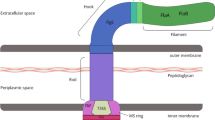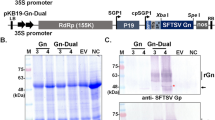Abstract
The expression of sialoglycoconjugates in Fonsecaea pedrosoi conidia, mycelia, and sclerotic cells was analyzed using influenza A and C virus strains, sialidase treatment, and lectin binding. Conidium and mycelium whole cells were recognized by Limax flavus (LFA), Maackia amurensis (MAA), and Sambucus nigra (SNA) lectins, denoting the presence of surface sialoglycoconjugates containing α2,3- and α2,6-sialylgalactosyl sequences. Sialidase-treated conidia reacted more intensively with peanut agglutinin (PNA), confirming the occurrence of sialyl-galactosyl linkages. Conidial cells agglutinated in the presence of influenza A and C virus strains, which confirmed the results obtained from lectin-binding experiments and revealed the presence of sialoglycoconjugates bearing 9-O-acetyl-N-acetylneuraminic acid (Neu5,9Ac2) surface structures. Western blotting analysis with peroxidase-labeled LFA demonstrated the occurrence of sialylglycoproteins in protein extracts from conidia and mycelia, with molecular masses corresponding to 56 and 40 kDa. An additional band of 77 kDa was detected in conidial extracts, suggesting an association between sialic acid expression and morphogenesis. Synthesis of sialic acids was correlated with sialidase expression, since both conidial and mycelial morphological stages presented secreted and cell-associated enzyme activity. Sialoglycoconjugates were not detected in F. pedrosoi sclerotic cells from in vitro and in vivo sources, which also do not express sialidase activity. The surface sialyl residues in F. pedrosoi are apparently involved in the fungal interaction with immune effector cells, since sialidase-treated conidia were less resistant to phagocytosis by human neutrophils from healthy individuals. These findings suggest that sialic acid expression in F. pedrosoi varies according to the morphological transition and may protect infecting propagules against immune destruction by host cells.




Similar content being viewed by others
References
Alaei S, Larcher C, Ebenbichler C, Prodinger WN, Janatova J, Dierich MP (1993) Isolation and biochemical characterization of the iC3b receptor of Candida albicans. Infect Immun 61:1395–1399
Alviano CS, Pereira MEA, De Souza W, Oda LM, Travassos LR (1982) Sialic acids are surface components of Sporothrix schenckii yeast forms. FEMS Microbiol Lett 15:223–227
Alviano CS, Farbiarz SR, De Souza W, Angluster J, Travassos LR (1991) Characterization of Fonsecaea pedrosoi melanin. J Gen Microbiol 137:837–844
Alviano CS, Travassos LR, Angluster J, de Souza W (1992) Effect of environmental factors on Fonsecaea pedrosoi morphogenesis with emphasis on sclerotic cells induced by propranolol. Mycopathologia 119:17–23
Alviano CS, Travassos LR, Schauer R (1999) Sialic acids in fungi: a minireview. Glycoconj J 16:545–554
Alviano DS, Kneipp LF, Lopes AH, Travassos LR, Meyer-Fernandes JR, Rodrigues ML, Alviano CS (2003). Differentiation of Fonsecaea pedrosoi mycelial forms into sclerotic cells is induced by platelet-activating factor. Res Microbiol 154:689–695.
Angata T, Varki A (2002) Chemical diversity in the sialic acids and related α-keto acids: An evolutionary perspective. Chem Rev 102:439–469
Arduino RC, Jacques-Palaz K, Murray BE, Rakita RM (1994) Resistance of Enterococcus faecium to neutrophil-mediated phagocytosis. Infect Immun 62:5587–5594
Bouali A, Robert R, Tronchin G, Senet JM (1987) Characterization of binding of human fibrinogen to the surface of germ tubes and mycelium of Candida albicans. J Gen Microbiol 133:545–551
Bouchara JP, Tronchin G, Annaix V, Robert R, Senet JM (1990) Laminin receptors on Candida albicans germ tubes. Infect Immun 58:48–54
Butterfield W, Jong SC (1987) Effect of carbon source on conidiogenesis in Fonsecaea dermatitidis, agent of chromomycosis. Mycopathologia 58:59–62
Castro LGM, Pimentel ERA, Lacaz CS (2003) Treatment of chromoblastomycosis by cryosurgery with liquid nitrogen: 15 years’experience. Int J Dermatol 42:408–412
Couceiro JNSS, Paulson JC, Baum LG (1993) Influenza virus strains selectively recognize sialyloligosaccharides on human respiratory epithelium; the role of the host cell in selection of hemagglutinin receptor specificity. Virus Res 29:155–165
Esquenazi D, Rozental S, Alviano CS, Travassos LR, Schauer R (2003) Sialic acids are absent from the dermatophytes Trichophyton mentagrophytes and Trichophyton rubrum. Mycoses 46:1–6
Esterre P, Peyrol S, Sainte-Marie D, Pradinaud R, Grimaud JA (1993) Granulomatous reaction and tissue remodeling in the cutaneous lesion of chromoblastomycosis. Virchows Archiv A Patho Anat 422:285–291
Farbiarz SR, De Carvalho TU, Alviano CS, De Souza W (1990) Fine structure and cytochemistry of the interaction between Fonsecaea pedrosoi and mouse resident macrophages. J Med Vet Mycol 28:373–383
Farbiarz SR, Carvalho TU, Alviano CS, De Souza W (1992) Inhibitory effect of melanin on the interaction of Fonsecaea pedrosoi with mammalian cells in vitro. J Med Vet Mycol 30:265–273
Hamilton AJ, Jeavons L, Hobby P, Hay RJ (1992) A 34 to 38 kilodalton Cryptococcus neoformans glycoprotein produced as an exoantigen bearing a glycosylated species-specific epitope. Infect Immun 60:143–149
Hamza SH, Mercado PJ, Skelton HG, Smith KJ (2003) An unusual dematiaceous fungal infection of the skin caused by Fonsecaea pedrosoi: a case report and review of the literature. J Cutan Pathol 30:340–343
Hulb U, Ishida H, Kiso M, Hasegawa A, Schauer R (2000) Studies on the specificity and sensitivity of the Influenza C virus binding assay for 9-O-acetylated sialic acids and its application to human melanomas. J Biochem 127:1021–1031
Jedrzejas MJ (2001) Pneumococcal virulence factors: structure and function. Microbiol Mol Biol Rev 65:187–207
Jost BH, Songer JG, Billington SJ (2001) Cloning, expression, and characterization of a neuraminidase gene from Arcanobacterium pyogenes. Infect Immun 69:4430–4437
Krug G, Roggentin P, Schauer R, Brasch J (1997) Dermatophyten bilden in vitro keine sialidase. Mycoses 40:17–21
Kwon-Chung KJ, Bennet JE (1992) Chromoblastomycosis. In: Medical Mycology. Lea & Febiger, Philadelphia, pp 337–355
Laemmli UK (1970) Cleavage of structural proteins during the assembly of the head of bacteriophage T4. Nature 227:680–685
Limongi CL, Alviano CS, De Souza W, Rozental S (2001) Isolation and partial characterization of an adhesin from Fonsecaea pedrosoi. Med Mycol 39:429–437
Lowry OH, Rosebrogh NJ, Farr AL, Randall RJ (1951) Protein measurement with the Folin phenol reagent. J Biol Chem 193:265–275
McGinnis MR, Hilger EA (1987) Infections caused by black fungi. Arch Dermatol 123:1300–1302
Mendoza L, Karuppayil SM, Szaniszlo PJ (1993) Calcium regulates in vitro dimorphism in chromoblastomycotic fungi. Mycoses 36:157–164
Oda LM, Kubelka CF, Alviano CS, Travassos LR (1983) Ingestion of yeast forms of Sporotrix schenckii by mouse peritoneal macrophages. Infect Immun 39:497–504
Oliveira LG, Resende MA, Lopes CF, Cisalpino EO (1973) Isolamento e identificação dos agentes da cromomicose em Belo Horizonte. Rev Soc Bras Med Trop 7:1 (in Portuguese).
Orskov F, Orskov I, Sutton A, Schenckman R, Lin W, Egan W, Hoff EG, Robbins JB (1979) Form variation in Escherichia coli K1 determined by O-acetylation of the capsular polysaccharide. J Exp Med 152:1375–1392
Potier M, Mameli L, Bélisle M, Dallaire L, Melançon SB (1979) Fluorometric assay of neuraminidase with a sodium (4-methylumbelliferyl-α-D-N-acetylneuraminate) substrate. Anal Biochem 94:287–296
Reuter G, Schauer R (1994) Determination of sialic acids. Methods Enzymol 230:168–199
Rivitti EA, Aoki V (1999) Deep fungal infections in tropical countries. Clin Dermatol 17:171–190
Rodrigues ML, Rozental S, Couceiro JNSS, Angluster J, Alviano CS, Travassos LR (1997) Identification of N-acetylneuraminic acid and its 9-O-acetylated derivative on the cell surface of Cryptococcus neoformans: influence on fungal phagocytosis. Infect Immun 65:4937–4942
Rodrigues ML, Alviano CS, Travassos LR (1999) Pathogenicity of Cryptococcus neoformans: virulence factors and immunological mechanisms. Microbes Infect 1:293–301
Rodrigues ML, Dobroff ASS, Couceiro JNSS, Alviano CS, Schauer R, Travassos LR (2003) Sialylglycoconjugates and sialyltransferases activity in the fungus Cryptococcus neoformans. Glycoconjugate J 19:165–173
Rogers GN, Herrier G, Paulson JC, Klenk HD (1986) Influenza C virus uses 9-O-acetylneuraminic as a high affinity receptor determinant for attachment to cells. J Biol Chem 261:5947–5951
Roggentin P, Krug G, Schauer R, Brasch J (1999) Lack of sialidase activity in Candida albicans and Candida glabrata. Mycoses 42:33–36
Rosen T, Overholt M (1996) Persistent viability of the medlar body. Int J Dermatol 35:96–98
Royal GC Jr, Nandedkar AK, Sampson CC, Faggett T (1984) Neuraminidase production by Candida albicans. J Natl Med Assoc 76:143–145
Rozental S, Alviano CS, De Souza W (1996) Fine structure and cytochemical study of the interaction between Fonsecaea pedrosoi and rat polymorphonuclear leukocyte. J Med Vet Mycol 34:323–330
Schauer R, Kamerling JP (1997) Chemistry, biochemistry and biology of sialic acids. In: Montreuil J, Vliegenthart JFG, Schachter H (eds) Glycoproteins II, vol 29b. New Comprehensive Biochemistry, Elsevier Science, Amsterdam, pp 243–402
Schnitzler N, Peltroche-Llacsahuanga H, Bestier N, Zündorf J, Lütticken R, Haase G (1999) Effect of melanin and carotenoids of Exophiala (Wangiella) dermatitidis on phagocytosis, oxidative burst, and killing by human neutrophils. Infect Immun 67:94–101
Silva JP, de Souza W, Rozental S (1999) Chromoblastomycosis: a retrospective study of 325 cases on Amazonic region (Brazil). Mycopathologia 143:171–175
Silva JP, Alviano DS, Alviano CS, De Souza W, Travassos LR, Diniz JAP, Rozental S (2002) Comparison of Fonsecaea pedrosoi sclerotic cells obtained in vivo and in vitro: ultrastructure and antigenicity. FEMS Immunol Med Microbiol 33:63–69
Soares RMA, Angluster J, de Souza W, Alviano CS (1995) Carbohydrate and lipid components of hyphae and conidia of human pathogen Fonsecaea pedrosoi. Mycopathologia 132:71–77
Soares RMA, Costa e Silva-Filho F, Rozental S, Angluster J, de Souza W, Alviano CS, Travassos LR (1998) Anionogenic groups and surface sialoglycoconjugate structures of yeast forms of the human pathogen Paracoccidioides brasiliensis. Microbiology 144:309–314
Soares RMA, Soares RMA, Alviano DS, Angluster J, De Souza W, Alviano CS, Travassos lr (2000) Identification of sialic acids on the cell surface of Candida albicans. Biochim Biophys Acta 1474:262–268
Souza ET, Silva-Filho FC, De Souza W, Alviano CS, Angluster J, Travassos LR (1986) Identification of sialic acids on the cell surface of hyphae and conidia of the human pathogen Fonsecaea pedrosoi. J Med Vet Mycol 24:145–153
Tronchin G, Bouchara JP, Robert R, Senet JM (1988) Adherence of Candida albicans germ tubes to plastic: ultrastructural and molecular studies of fibrillar adhesins. Infect Immun 56:1987–1993
Uchida Y, Tsukada Y, Sugimori T (1974) Production of microbial neuraminidases induced by colominic acid. Biochim Biophys Acta 350:425–431
Wadsworth E, Prasad SC, Calderone R (1993) Analysis of mannoproteins from blastoconidia and hyphae of Candida albicans with a common epitope recognized by anticomplement receptor type 2 antibodies. Infect Immun 61:4675–4681
Warren L (1959) The thiobarbituric assay of sialic acids. J Biol Chem 234:1971–1975
Wasylnka JA, Simmer MI, Moore MM (2001) Differences in sialic acid density in pathogenic and non-pathogenic Aspergillus species. Microbiology 147:869–877
Acknowledgements
The authors thank Fátima Regina de Vasconcelos Goulart for technical assistance. This work was supported by Programa de Apoio a Núcleos de Excelência (PRONEX), Conselho Nacional de Desenvolvimento Científico e Tecnológico (CNPq), Fundação de Amparo a Pesquisa do Estado do Rio de Janeiro (FAPERJ), Fundação Universitária José Bonifácio (FUJB) and Fundação Coordenação de Aperfeiçoamento de Pessoal de Nível Superior (CAPES).
Author information
Authors and Affiliations
Corresponding author
Rights and permissions
About this article
Cite this article
Alviano, D.S., Rodrigues, M.L., Almeida, C.A. et al. Differential expression of sialylglycoconjugates and sialidase activity in distinct morphological stages of Fonsecaea pedrosoi . Arch Microbiol 181, 278–286 (2004). https://doi.org/10.1007/s00203-004-0653-9
Received:
Revised:
Accepted:
Published:
Issue Date:
DOI: https://doi.org/10.1007/s00203-004-0653-9




